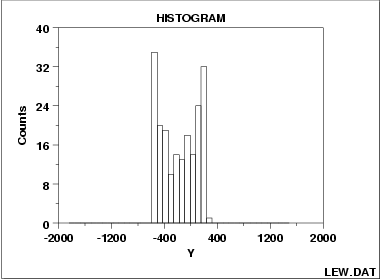1.3. EDA Techniques
1.3.3. Graphical Techniques: Alphabetic
1.3.3.14. Histogram
1.3.3.14.4. |
Histogram Interpretation: Symmetric and Bimodal |

The mode of a distribution is that value which is most frequently occurring or has the largest probability of occurrence. The sample mode occurs at the peak of the histogram.
For many phenomena, it is quite common for the distribution of the response values to cluster around a single mode (unimodal) and then distribute themselves with lesser frequency out into the tails. The normal distribution is the classic example of a unimodal distribution.
The histogram shown above illustrates data from a bimodal (2 peak) distribution. The histogram serves as a tool for diagnosing problems such as bimodality. Questioning the underlying reason for distributional non-unimodality frequently leads to greater insight and improved deterministic modeling of the phenomenon under study. For example, for the data presented above, the bimodal histogram is caused by sinusoidality in the data.
- Do a run sequence plot or a scatter plot to check for sinusoidality.
- Do a lag plot to check for sinusoidality. If the lag plot is elliptical, then the data are sinusoidal.
- If the data are sinusoidal, then a spectral plot is used to graphically estimate the underlying sinusoidal frequency.
- If the data are not sinusoidal, then a Tukey Lambda PPCC plot may determine the best-fit symmetric distribution for the data.
- The data may be fit with a mixture of two distributions. A
common approach to this case is to fit a mixture
of 2 normal or
lognormal distributions.
Further discussion of fitting mixtures of distributions is
beyond the scope of this Handbook.

